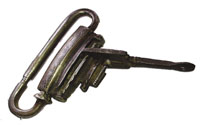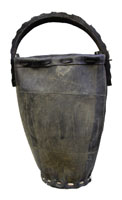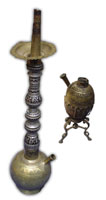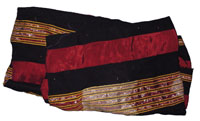
Eight Yemeni handcrafts are extinct (Part 4) [Archives:2008/1132/Culture]
February 25 2008
 |
 |
 |
 |
 |
For Yemen Times
Many traditional Yemeni handcrafts are in great demand due to their elegant style and the high quality of raw materials used. However, many more have disappeared completely or are in danger of losing their identity because each craft demands a set of specialized skills and raw materials of high quality. Because Yemen's raw materials are exported outside the country, their prices have increased.
A December 2007 field study attempting to catalog and document traditional handcrafts in the Old City of Sana'a found that while 28 percent the area's residents are craftsmen, most have discontinued such work for several reasons, most importantly, low income and more cheaply imported similar handcrafts.
A national team from Yemen's General Organization of Antiquities, Museums and Manuscripts, under the auspices of the Social Fund for Development, worked for a year to document all Yemeni handcrafts in the Old City of Sana'a, which are an important part of the nation's cultural heritage created by various civilizations throughout centuries of history. Thus, they are experiences handed down from generation to generation.
The seven-member research team consisted of: Amat Al-Bari Al-Adi, Amat Al-Razzaq Jahaf, Abdulqadir Al-Shaibani, Zaid Al-Faqih, Ibrahim Al-Hadid and Abdulaziz Ibrahim.
Team leader Al-Adi believes that imported handcrafts affect Yemeni handcrafts. According to initial team estimates, Jahaf says only 35 percent of such handcrafts exist today in the Old City, which threatens artisans with losing their livelihoods.
Further, because raw materials have become rare, many artisans depend on exported raw materials, which affects the quality of the handcrafts.
Al-Adi explained that in order to reach those outcomes, the team conducted its research in four stages, the first of which was a survey to determine the number of handcrafts, artisans and handcraft shops. The survey involved the type of handcraft, the number of shops selling it and the name of the street where it's located.
The team leader continued, “Next, we analyzed the results and used them to apply stage two,” which was collecting the historical background of the 27 Yemeni handcrafts
“Stage three was preparing a meeting of specialists in this field to study what we did and to continue our work of cataloging the handcrafts,” Al-Adi noted. The final stage was a comprehensive field study wherein the team surveyed and documented Old City handcrafts by photographing and recording everything, even the songs the artisans sing while they work.
Totally extinct handcrafts
Eight of 27 Yemeni handcrafts now have vanished completely. They are: the meda'a (a charcoal smoking pipe), dalow (a leather bucket), al-salb (a rope made of leather), spun cotton and wool, fabric/textile making, al-duro'a al-nuhasiya (worn atop maghamaq) and Al-Ghathaimi iron locks.
Meda'a
This handcraft industry now is completely extinct. Yemenis use the meda'a to smoke tobacco. Due to its beautiful shape, it's also used for decoration.
Today's madyee (plural of meda'a) are imported from India, with Yemeni crafters only interested in welding and repairing them.
Dalow (a leather bucket)
This is a traditional bucket made of leather. Due to the large quantity of locally dyed leather, many industries emerged using it.
However, as Jahaf pointed out, “Using this type of traditional bucket has become completely extinct due to today's more advanced machines used to fetch water.”
Al-salb (a rope made of leather)
These ropes are made of cow leather, which first is cut into between six and 10 long thin pieces, which then are placed in water to become soft and flexible. Afterward, they are braided together and then rubbed with al-terter or al-jiljelan oil.
However, today's citizens prefer using ropes made of plastic rather than leather.
Spun cotton and wool
These two handcrafts prove that Yemen once was a significant industrial nation, “But today, we import everything we need from outside Yemen, despite the fact that the local industries were high quality and exhibited a high degree of accuracy,” according to Jahaf.
Fabric/textile making
The Old City of Sana'a now has lost all of its crafters making al-farid, a type of cloth made of woolen thread or al-masawen textile, al-abah (the traditional abaya) and al-masawen textiles, according to Al-Adi.
All of those places in the Old City making traditional abayas, cotton shawls and al-masawen textiles now have closed completely, with most crafters having abandoned it to weave ma'awiz (sarongs). However, according to Jahaf, this too is quite obscure today despite significant changes occurring in the traditional features regarding making them.
“We don't know the exact time period of this handcraft or when Yemenis began using natural resources to produce textiles,” Jahaf noted, “However, according to our research, it was around 2,500 B.C. Yemeni textiles flourished more globally during the 13th and 14th centuries.”
Al-duro'a al-nuhasiya
Al-duro'a al-nuhasiya is made of copper wires or threads and then worn atop a woman's maghamaq, a traditional face covering made of pure silk and called ghanami or, if made of cotton, it's called baqari. Maghamaq textile initially is white and then dyed with red and black.
There are two types of maghamaq – mudara'a and musadaf. The first type is called al-mudara'a because it looks like traditional chain mail armor, while the second type is called musadaf because it looks like shells (sadafa means shell in Arabic).
A small piece of cloth is affixed on top of the maghamaq. It is embroidered with glittering threads and decorated with numerous colored threads, shells and duro'a nuhasiya. Depending on its type, al-duro'a al-nuhasiya typically is woven into a triangular shape.
Al-Ghathaimi iron locks
“An Al-Ghathaimi lock consists of 22 iron pieces,” Jahaf explained, adding, “The idea for this type of lock originated with Yemenis.”
She continued, “The reason this type of lock was created is that blacksmiths used to make both agricultural tools and guns. A sultan once invited a Yemeni blacksmith to conclude a contract to make al-damnasis rifles, which were famed at that time.
“The blacksmith agreed, but tribesmen later discovered that this type of rifle was backfiring and shooting its user. Enraged, the tribes wanted to take the revenge upon the blacksmiths as the makers of this rifle,” Jahaf recounted.
Afterward, blacksmiths stopped working in this handcraft completely and began making iron locks instead of rifles.
Jahaf added, “The lock is named Al-Ghathaimi for the Ghathim family, which played a significant role in expanding the handcraft.”
——
[archive-e:1132-v:15-y:2008-d:2008-02-25-p:culture]


